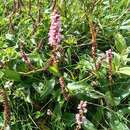en
names in breadcrumbs


Hook. f., Fl. Brit. India 5: 32. 1885 reported from Scinde (Sind) to Sikkim. However, this seems to be an error as there are no high mountains in Sind. This taxon is present from Garhwal eastward.
Bistorta macrophylla (syn. Polygonum macrophyllum, syn. Persicaria macrophylla) is a flowering plant species in the buckwheat family Polygonaceae.[1] It is native to mountain regions of West and South China (Gansu, Guizhou, Henan, Hubei, Qinghai, Shaanxi, Sichuan, Tibet, Yunnan), Bhutan, Nepal,[2] northern India (Himachal Pradesh, Uttarakhand), and Pakistan.
In Nepal, its rhizomes are dried to be used as food.[3]
In India (Uttarakhand), its leaves are used in traditional medicine to treat wounds.[4] The paste made from the roots is given to infants for stomach problems.[5]
Vernacular names:
Compounds (-)-Epicatechin-5-O-beta-D-glucopyranoside, (+)-catechin-7-O-beta-D-glucopyranoside, 1-(3-O-beta-D-glucopyranosyl 4,5-dihydroxy-phenyl)-ethanone, (-)-epicatechin, chlorogenic acid and gallic acid can be found in the species.[6]
Bistorta macrophylla (syn. Polygonum macrophyllum, syn. Persicaria macrophylla) is a flowering plant species in the buckwheat family Polygonaceae. It is native to mountain regions of West and South China (Gansu, Guizhou, Henan, Hubei, Qinghai, Shaanxi, Sichuan, Tibet, Yunnan), Bhutan, Nepal, northern India (Himachal Pradesh, Uttarakhand), and Pakistan.
In Nepal, its rhizomes are dried to be used as food.
In India (Uttarakhand), its leaves are used in traditional medicine to treat wounds. The paste made from the roots is given to infants for stomach problems.
Vernacular names:
English: red knotweed or large leaved knotweed Chinese: 圆穗拳参; pinyin: yuan sui quan shen Nepali: Dalle ghans, Dalle jhar India: Kukhri, Chhota ninayin, Kande-re-ninaiCompounds (-)-Epicatechin-5-O-beta-D-glucopyranoside, (+)-catechin-7-O-beta-D-glucopyranoside, 1-(3-O-beta-D-glucopyranosyl 4,5-dihydroxy-phenyl)-ethanone, (-)-epicatechin, chlorogenic acid and gallic acid can be found in the species.